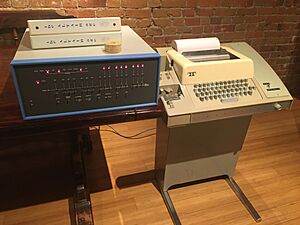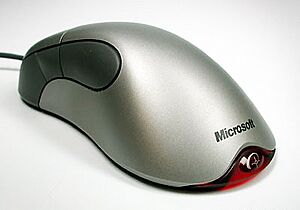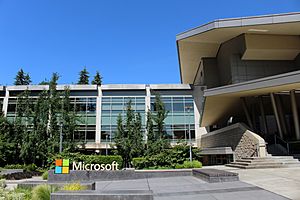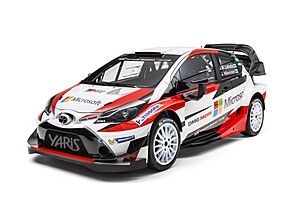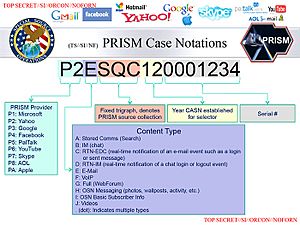Microsoft facts for kids

Logo used since 2012
|
|||
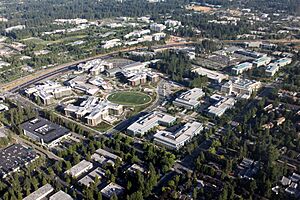
Aerial view of the Microsoft campus in Redmond
|
|||
| Public | |||
| Traded as | |||
| ISIN | ISIN: [https://isin.toolforge.org/?language=en&isin=US5949181045 US5949181045] | ||
| Industry | Information technology | ||
| Predecessor | Traf-O-Data | ||
| Founded | April 4, 1975 in Albuquerque, New Mexico, U.S. | ||
| Founders | |||
| Headquarters | One Microsoft Way,
,
U.S.
|
||
|
Area served
|
Worldwide | ||
|
Key people
|
|
||
| Products |
|
||
| Brands |
|
||
| Services |
|
||
| Revenue | |||
|
Operating income
|
|||
| Total assets | |||
| Total equity | |||
|
Number of employees
|
228,000 (2025) | ||
| Divisions |
|
||
| Subsidiaries | |||
|
|||
| Footnotes / references Financials as of June 30, 2025[update]. |
|||
Microsoft Corporation is a huge American technology company. It is based in Redmond, Washington. Started in 1975, Microsoft helped make personal computers popular. It did this with software like Windows. Since then, the company has grown into many areas. These include Internet services, cloud computing, and video gaming. Microsoft is known as the largest software maker. It is also one of the most valuable companies in the U.S. and worldwide.
Bill Gates and Paul Allen started Microsoft. They wanted to create and sell computer programs called BASIC interpreters for the Altair 8800 computer. Microsoft became very successful with its MS-DOS operating system in the mid-1980s. Then came Windows. From 1980 to 2021, Microsoft released many versions of MS-DOS and Windows. When the company first offered its shares to the public in 1986, it made many employees millionaires.
Since the 1990s, Microsoft has explored new areas beyond just operating systems. Steve Ballmer became CEO in 2000. He led big purchases, like Skype Technologies in 2011. He also focused more on hardware, leading to the Surface computers in 2012. In 2014, Satya Nadella became CEO. He shifted the company's focus to cloud computing. Microsoft also bought LinkedIn in 2016 and expanded its Xbox video game business. In 2023, it bought Activision Blizzard, a huge video game company.
Microsoft is a leader in computer operating systems and office software. Its most famous products are the Windows operating systems. It also makes Microsoft Office and Microsoft 365. These include programs like Microsoft Word for writing, Microsoft Excel for spreadsheets, and Microsoft PowerPoint for presentations. Its main hardware products are the Surface computers and Xbox video game consoles. Microsoft also offers internet services like Bing search and Outlook.com email. For businesses, it provides the Azure cloud platform and Visual Studio for developers.
Microsoft is one of the "Big Five" American technology companies. The others are Alphabet (Google's parent company), Amazon, Apple, and Meta (Facebook's parent company). In 2019, Microsoft became one of the few U.S. companies valued at over $1 trillion. The company has faced some criticism. This includes concerns about its business practices and the security of its software.
The Story of Microsoft
How Microsoft Began (1972–1985)
Childhood friends Bill Gates and Paul Allen loved computer programming. In 1972, they started a small company called Traf-O-Data. It sold a simple computer to track traffic data. Gates went to Harvard University, and Allen worked at Honeywell.
In 1975, they saw an article about the Altair 8800 computer. Allen thought they could create a BASIC program for it. Gates called the company, MITS, and said they had a working program. They showed it to MITS in March 1975, and it worked perfectly. MITS agreed to sell it as Altair BASIC.
Gates and Allen officially started Microsoft on April 4, 1975. Gates was the CEO. Allen suggested the name "Micro-Soft," meaning micro-computer software. In 1977, Microsoft opened its first international office in Japan. In 1979, the company moved its main office to Bellevue, Washington.
Microsoft got into the operating system business in 1980. It created a version of Unix called Xenix. But MS-DOS made the company famous. IBM hired Microsoft in 1980 to provide an operating system for its new IBM Personal Computer. Microsoft bought a program called 86-DOS and renamed it MS-DOS. IBM used it as IBM PC DOS. Microsoft kept the rights to MS-DOS. This helped it become the top seller of PC operating systems.
In 1983, Microsoft released the Microsoft Mouse. It also started a publishing part of the company called Microsoft Press. Paul Allen left Microsoft in 1983 after getting sick.
Windows and Office Take Off (1985–1994)
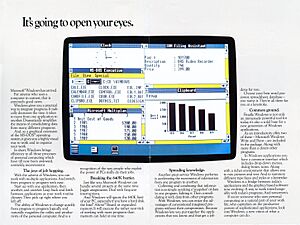
Microsoft launched Windows 1.0 on November 20, 1985. It was a graphical add-on for MS-DOS. On February 26, 1986, Microsoft moved its headquarters to Redmond, Washington. On March 13, it became a public company. This made many Microsoft employees very rich.
In 1990, Microsoft released Microsoft Office. This was a collection of programs like Microsoft Word and Microsoft Excel. On May 22, Microsoft launched Windows 3.0. It had a better look and worked well with newer processors. Both Office and Windows became very popular.
The U.S. government looked into Microsoft's business practices. They were concerned about how Microsoft licensed its software.
Exploring the Internet and Xbox (1995–2007)
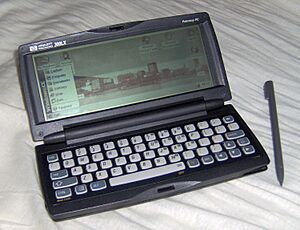
In 1995, Bill Gates wrote a memo about the "Internet Tidal Wave." Microsoft then started focusing on the World Wide Web. The company quickly became a major player online.
Microsoft released Windows 95 on August 24, 1995. It had a new look with a Start menu. It also came with MSN, an online service, and Internet Explorer, a Web browser. Windows 95 was a huge success. In 1996, Microsoft created MSNBC, a news channel, with General Electric's NBC. Microsoft also made Windows CE, an operating system for small devices.
On January 13, 2000, Bill Gates stepped down as CEO. His friend Steve Ballmer took over. Gates became the Chief Software Architect. In 2000, a court ruled that Microsoft was an "abusive monopoly." Microsoft later settled this case in 2004.

On October 25, 2001, Microsoft released Windows XP. This version combined different Windows lines into one. Later that year, Microsoft entered the video game market with the Xbox. This put them in competition with Sony and Nintendo. In 2004, the European Union fined Microsoft. They said Microsoft was misusing its power with Windows. In 2005, Microsoft released its second video game console, the Xbox 360.
Microsoft also made other hardware. In 2006, it released the Zune digital music players. The company also sold popular keyboards, mice, and webcams. In 2007, Microsoft launched the Surface "digital table."
Cloud, Windows 7, and Stores (2007–2011)
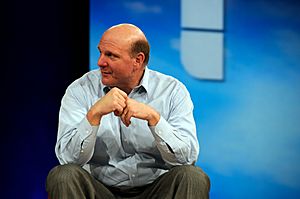
In January 2007, Microsoft released Windows Vista. It had new features and a redesigned look called Aero. Microsoft Office 2007 also came out with a new "Ribbon" interface. Both products sold well. The European Union fined Microsoft again in 2008 for not following earlier rules.
Bill Gates stepped down from his full-time role in 2008. He remained an advisor. On October 27, 2008, Microsoft launched Azure Services Platform. This was its entry into cloud computing. In 2009, Microsoft announced plans to open its own retail stores. The first Microsoft Store opened in October 2009. On the same day, Windows 7 was released. Windows 7 focused on making Vista better and easier to use.
As smartphones became popular, Microsoft worked to improve its mobile operating system. In 2010, it replaced Windows Mobile with Windows Phone. This new system had a fresh, simple design. Microsoft also partnered with Nokia in 2011 to develop Windows Phone.
Windows 8, Xbox One, and Surface (2011–2014)
Microsoft updated its products with a new design style in 2011 and 2012. In June 2011, Microsoft showed off Windows 8. This operating system was made for both personal computers and tablet computers. The Surface tablet was revealed in June 2012. It was the first computer where Microsoft made the hardware itself. Microsoft also bought the social network Yammer and launched the Outlook.com email service.
In 2013, Microsoft released the Xbox One video game console. It came with an improved Kinect motion sensor. In July 2013, Microsoft reorganized its business into four main areas: Operating Systems, Apps, Cloud, and Devices. In September 2013, Microsoft agreed to buy Nokia's mobile phone business.
Windows 10, Edge, and HoloLens (2014–2020)
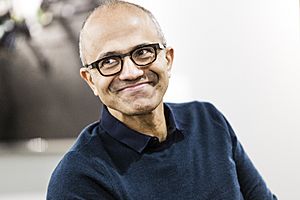
On February 4, 2014, Satya Nadella became the new CEO of Microsoft. He had previously led Microsoft's Cloud and Enterprise division. John W. Thompson became the new chairman. In April 2014, Microsoft completed its purchase of Nokia Devices and Services. In September 2014, Microsoft bought the video game company Mojang, known for Minecraft.
On January 21, 2015, Microsoft announced the Surface Hub, an interactive whiteboard. Windows 10 was released on July 29, 2015. In 2015, Microsoft was the third-largest maker of mobile phones. However, the company lost a lot of money on its mobile phone business and laid off many employees.
In March 2016, Microsoft combined its PC and Xbox divisions. They focused on Universal Windows Platform (UWP) apps for gaming. In November 2016, Microsoft joined the Linux Foundation. This was a big step, as a former CEO had called Linux "cancer" years before.

In January 2018, Microsoft updated Windows 10 to fix CPU problems. In March 2018, Microsoft changed Windows 10 S from a separate operating system to a mode within Windows. In April 2018, Microsoft released the code for Windows File Manager for free. It also announced Azure Sphere, its own version of the Linux operating system.
In May 2018, Microsoft worked with U.S. intelligence agencies to develop cloud computing products. On June 4, 2018, Microsoft bought GitHub, a popular platform for software developers. In July 2018, it released the Surface Go tablet.
In August 2018, Toyota Tsusho partnered with Microsoft. They used Microsoft Azure to create tools for fish farming. In November 2018, Microsoft agreed to provide Microsoft HoloLens headsets to the U.S. military. These headsets help soldiers train and improve their skills. Microsoft also released Project Mu, an open-source version of its firmware. It also made parts of Windows Forms and Windows Presentation Foundation open source.
In February 2019, Microsoft offered its AccountGuard cybersecurity service to more countries in Europe. This helps protect political groups from hacking.
New Acquisitions and Windows 11 (2020–Present)
On March 26, 2020, Microsoft bought Affirmed Networks. Due to the COVID-19 pandemic, Microsoft closed all its retail stores. On July 22, 2020, Microsoft announced it was closing its Mixer game streaming service.
On September 21, 2020, Microsoft announced it would buy the video game company ZeniMax Media, which owns Bethesda Softworks. This deal was completed in March 2021. On September 22, 2020, Microsoft announced it had a special license to use OpenAI's GPT-3 artificial intelligence. On November 10, 2020, Microsoft released the Xbox Series X and Xbox Series S video game consoles.
In April 2021, Microsoft announced it would buy Nuance Communications, a company known for its speech recognition technology. This purchase was completed in March 2022. In 2021, Microsoft's value grew to nearly $2 trillion. This was partly because of increased demand for remote work and distance education during the pandemic.
On June 24, 2021, Microsoft announced Windows 11. It was released to the public on October 5, 2021. In September 2021, Microsoft bought Takelessons, an online platform for tutors. It also acquired Clipchamp, a video editing software company.
In October 2021, Microsoft added end-to-end encryption for Microsoft Teams calls. This helps keep business conversations private. On October 7, Microsoft bought Ally.io, a software service for tracking company goals.
On January 18, 2022, Microsoft announced its plan to buy Activision Blizzard for $68.7 billion. This is a huge video game company known for games like Warcraft, Call of Duty, and Candy Crush Saga. This deal was completed on October 13, 2023. Microsoft also created a new Microsoft Gaming division.
In December 2022, Microsoft made a 10-year deal with the London Stock Exchange Group. As part of the deal, Microsoft bought about 4% of the LSEG. In January 2023, CEO Satya Nadella announced that Microsoft would lay off about 10,000 employees. On January 23, 2023, Microsoft announced a new investment deal with ChatGPT creator OpenAI.
In June 2023, Microsoft released Azure Quantum Elements. This service helps with molecular simulations using AI and quantum computing. In November 2023, Microsoft announced two new computer chips: Maia for AI and Cobalt CPU for cloud services.
In November 2023, Sam Altman and Greg Brockman from OpenAI briefly joined Microsoft to lead a new AI research team. However, they soon returned to OpenAI. In March 2024, Microsoft hired almost all of the employees from Inflection AI to start Microsoft AI.
In January 2024, Microsoft became the most valuable publicly traded company. It also offered a new AI subscription for small businesses called Copilot Pro. In April 2024, Microsoft invested $1.5 billion in the Emirati AI firm G42. It also announced plans to invest $1.7 billion in AI and cloud in Indonesia.
In May 2024, Microsoft announced a $3.3 billion investment to build an AI hub in Wisconsin. This project will create many jobs and include an AI co-innovation lab. In June 2024, Microsoft announced layoffs in its mixed reality and Azure cloud divisions. It also announced a new data center in Leeds, England.
In July 2024, a global IT outage affected Microsoft services. This was caused by a flawed update from a cybersecurity software company. Microsoft said the problem was fixed, but some services still had issues. In September 2024, BlackRock and Microsoft announced a $30 billion fund to invest in AI infrastructure. Microsoft also relaunched its Recall tool, making it an optional feature after privacy concerns.
On February 28, 2025, Microsoft announced that Skype would be shutting down on May 5, 2025. This was to focus more on Microsoft Teams. On April 4, 2025, Microsoft celebrated its 50th anniversary. In May 2025, Microsoft's Russian division prepared to file for bankruptcy. In July 2025, Microsoft announced more layoffs, cutting about 9,000 jobs. It also announced it was leaving Pakistan.
How Microsoft Works
Microsoft is a very large company. It is ranked highly among the biggest U.S. companies by revenue. It is also one of the most valuable companies in the world.
Leaders and Board of Directors
The company is run by a board of directors. Most of these members are not employees of Microsoft. The board members are elected every year. They oversee different areas like finances, employee pay, and company rules.
On March 13, 2020, Bill Gates left Microsoft's board of directors. He wanted to focus more on his charity work.
The CEOs of Microsoft have been:
- Bill Gates (1975–2000)
- Steve Ballmer (2000–2014)
- Satya Nadella (2014–present)
Money Matters
When Microsoft first sold its shares to the public in 1986, the price was $21. Over the years, the stock price grew a lot. Microsoft started paying a dividend to its shareholders in 2003. This means it shares some of its profits with people who own its stock.
Microsoft has a very strong financial rating. In 2011, Apple Inc. earned more profits than Microsoft for the first time in 20 years. This was due to slower PC sales. In July 2012, Microsoft reported its first quarterly loss ever. This was due to a write-off related to an advertising company it had bought.
By 2014, Microsoft was one of the most valuable companies in the world. In 2015, it was reported that Microsoft had earned billions of dollars overseas that were not yet taxed in the U.S.
Company Culture
Microsoft provides many resources for developers and users. This includes the Microsoft Developer Network (MSDN) and community sites like Channel 9. Microsoft employees also use a special phrase: "eating your own dog food." This means they test new products themselves before releasing them to the public.
Microsoft has supported allowing more foreign workers to come to the U.S. with special visas. The company has also been recognized for its policies towards LGBT employees. In 2018, Microsoft started requiring its subcontractors to offer paid parental leave.
Caring for the Environment
In 2011, Greenpeace looked at how major cloud computing companies powered their data centers. They encouraged companies like Microsoft to use clean energy. In 2013, Microsoft agreed to buy wind power for one of its data centers.
Microsoft's main U.S. campus has received environmental certifications. It has also installed solar panels. Microsoft encourages employees to use public transport. It has a large private bus system called the "Connector."
In January 2020, Microsoft announced a goal to become "carbon negative" by 2030. This means it will remove more carbon from the atmosphere than it puts in. In October 2020, Microsoft permanently allowed remote work. In 2021, it joined the Climate Neutral Data Centre Pact.
In September 2023, Microsoft bought carbon credits to offset its carbon dioxide emissions. However, the company's total emissions still increased in 2023. In 2023, Microsoft used a lot of electricity, more than some entire countries.
Company Headquarters
Microsoft's main headquarters is in Redmond, Washington. It is a very large campus with many buildings. It has grown a lot since Microsoft first moved there in 1986. Many employees work there. Microsoft also has offices in other cities and countries. In April 2024, Microsoft announced a new AI hub in London, England.
Microsoft Stores
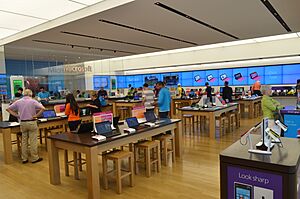
On October 26, 2015, Microsoft opened a large retail store on Fifth Avenue in New York City. This store helps the company connect with its customers. It opened at the same time as new Surface products were launched. Microsoft also opened a flagship store in Sydney, Australia.
Company Logo
Microsoft has had several logos over the years. In 1987, it adopted the "Pac-Man Logo." This logo had a slash between the "o" and "s" to show "soft" and suggest motion. This logo was used for 25 years.
- Microsoft logo history
-
February 26, 1987 – August 23, 2012: Microsoft "Pac-Man" logo, designed by Scott Baker.
On August 23, 2012, Microsoft revealed its current logo. It has four colored squares. These colors represent Microsoft's main products: Windows (blue), Office (orange), Xbox (green), and Bing (yellow).
Sponsorships
Microsoft has sponsored various sports teams. It was the official jersey sponsor for Finland's national basketball team. It also sponsored the Toyota Gazoo Racing WRT and the Renault F1 Team.
Helping Others
In 2015, Microsoft Philanthropies was created. This group helps bring technology to areas and groups that need it. They donate cloud computing resources and support computer science education. They also help global child and refugee relief organizations.
During the COVID-19 pandemic, Microsoft donated medical supplies to Seattle. During the Russian invasion of Ukraine, Microsoft monitored cyberattacks from Russia. In June 2022, Microsoft reported that Russian hackers had spied on governments and businesses in many countries.
Microsoft also supports programs that use AI to help people with disabilities.
Challenges and Criticisms
Microsoft has faced criticism for different reasons. Some people have raised concerns about how easy its software is to use, how strong it is, and its security. The company has also been criticized for its employment practices.
An Irish part of Microsoft reported huge profits in 2020 but paid no corporate tax. This was because the company was based in Bermuda for tax purposes. In 2020, it was reported that Microsoft had moved billions of dollars in U.S. profits to Puerto Rico. This made it seem like the company was not making much profit there, leading to very low taxes. The U.S. government later said Microsoft owed billions in past taxes.
Microsoft has been accused of using tactics to make it hard for competitors. This is sometimes called "embrace, extend, and extinguish." It means Microsoft would use existing standards, add its own special features, and then make it difficult for other companies to compete. This can lead to customers being "locked in" to Microsoft products.
According to some leaked documents, Microsoft was the first company to join the PRISM surveillance program in 2007. This program allowed the U.S. government to secretly access data of non-U.S. citizens from American companies without a warrant. Microsoft has denied participating in such a program.
In 2020, Salesforce, which makes the Slack platform, complained to European regulators about Microsoft. They said Microsoft was unfairly bundling its Teams service with Office 365. In June 2024, the European Commission officially accused Microsoft of abusing its market power by bundling Teams with its Office software. This could lead to a large fine.
In October 2024, Microsoft fired two employees who organized a vigil for Palestinians. These employees were part of a group called "No Azure for Apartheid." In February 2025, it was reported that the Israeli military was using Microsoft-developed AI tools. In May 2025, Microsoft confirmed these services were available to Israel.
In November 2024, the Federal Trade Commission (FTC) started an investigation into Microsoft. They are looking into possible unfair practices in its cloud computing, AI, and cybersecurity businesses. In June 2025, a UN expert's report said Microsoft was "central to Israel's surveillance apparatus."
Images for kids
-
Paul Allen and Bill Gates in 1981, after signing a contract with IBM.
See also
 In Spanish: Microsoft para niños
In Spanish: Microsoft para niños


